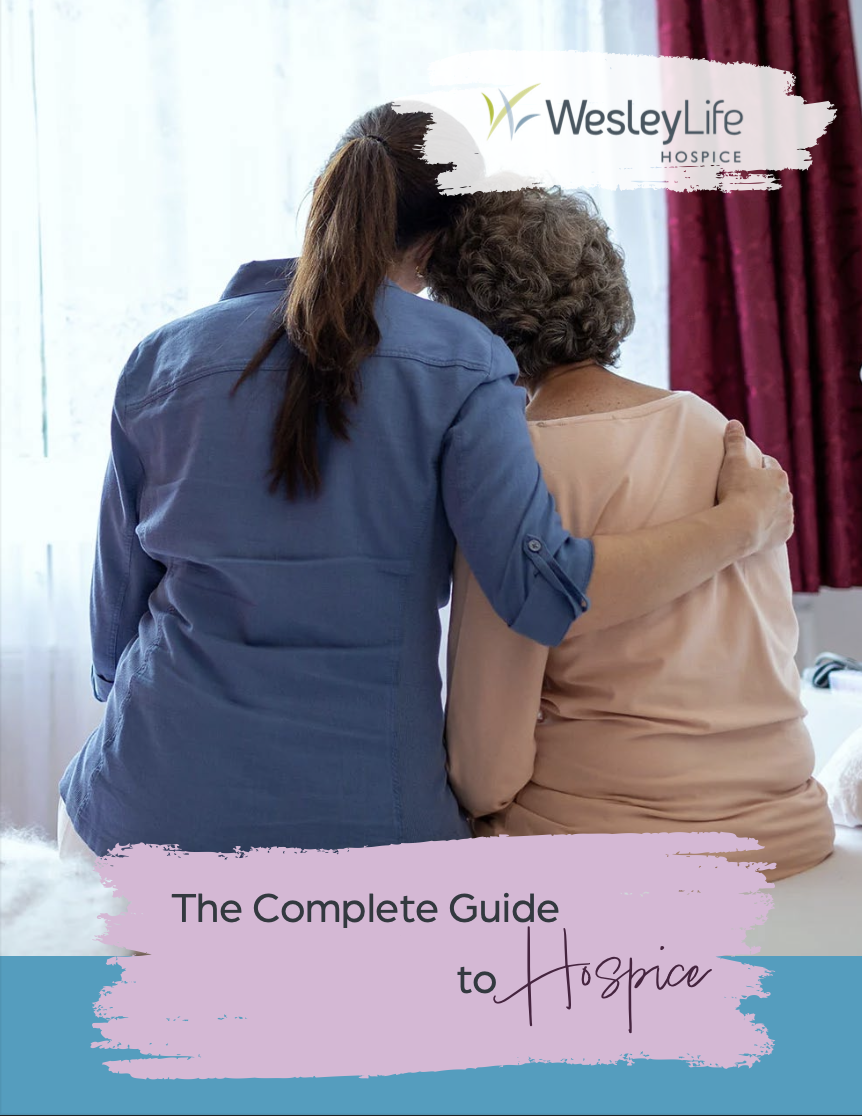The Complete Guide to Hospice

Introduction
Hospice care is commonly mischaracterized and misunderstood. In reality, hospice can help individuals live to the fullest throughout their final stage of life. Whatever clients and their families want their lives to look like at this stage, hospice teams are ready to help make that vision a reality, whether it means enhancing comfort, providing therapeutic experiences, encouraging fun and social interaction, or all of the above.
Learn all about hospice services so you can support your loved one’s well-being following the diagnosis of a life-limiting condition.

Download a PDF version of this guide by filling out this form, or keep scrolling to read.
Understanding Hospice Care
Making Decisions About Hospice
Talking to Your Loved One About Hospice Care
Paying for Hospice Care
Caregiving in Hospice
WesleyLife: An Enhanced Hospice Care Experience

Understanding Hospice Care
What is hospice care at home? Hospice care comprises a range of specialized services designed for individuals with life-limiting conditions. When curative treatments are no longer a viable option or a person chooses to forego these treatments, hospice care is a natural next step. The objective of hospice is not to cure or medically treat a person’s condition, but to manage symptoms, optimize comfort, and provide care for the whole person.
Hospice teams are interdisciplinary, consisting of physicians, nurses, social workers, and volunteers, so they’re well-equipped to provide multifaceted care. Hospice care addresses a client’s physical, emotional, social, and spiritual needs. Everything from hands-on nursing care to music and pet therapy can help individuals and families feel supported at each step of their journey.
Depending on a client’s needs, hospice care may include:
- Non-curative medical care
- Short-term inpatient care
- Medical equipment and supplies
- Home health aide and homemaker services
- Physical, speech, and/or occupational therapy
- Counseling services and spiritual support
- Bereavement services for loved ones
Hospice care is personalized to the individual, so the services involved can adapt to meet the client’s changing needs. Some clients may even choose to discontinue hospice if their prognosis changes. Hospice care is extremely flexible, meeting individuals’ and families’ unique needs in ways that make sense for them.

Making Decisions About Hospice
Understanding hospice is the first step in making decisions about this care. Next, families must consider their loved one’s particular situation to determine when and where the individual would be best served by hospice care.
Hospice Care Eligibility
A person is eligible for hospice care when their doctor diagnoses them with a life-limiting condition with a prognosis of six months or less. It’s always up to clients and families how they will proceed when they receive such a diagnosis; they can choose whether to engage in hospice or seek an alternative treatment option.
Typically, families reach out to hospice when one or more of these circumstances is true:
- Their loved one’s health is in serious decline.
- The person would prefer to discontinue curative medical treatment in favor of supportive care at home.
- The individual and their family are seeking guidance and support in living life to the fullest during this chapter.
- Family caregivers need professional assistance in caring for a loved one.
You should consult with your loved one and their medical team to develop a care plan and timeline that’s best for them. Remember, at-home hospice care is not just reserved for a person in their final days; many clients benefit from hospice care for months and may even live longer due to the way this care enhances their lives.
Choosing the Ideal Setting for Hospice Care
As you learn more about particular hospice providers, you’ll find that some offer hospice services in a hospice care center. However, most hospice clients choose to receive care in their homes. Hospice care at home allows clients to enjoy more of a sense of normalcy and familiarity during a time of transition. For most of us, home is where we feel most ourselves. Home hospice clients can continue to enjoy life’s simple pleasures, from that morning cup of coffee brewed in their own percolator to the way the evening sun streams into their living room.
Life may look different with hospice team members coming and going, but being home with loved ones is one of the sweetest blessings hospice care at home provides.

Talking to Your Loved One About Hospice Care
Despite its many benefits, hospice care can be a difficult topic to broach with a loved one. Emotions often run high when someone receives a life-limiting diagnosis or when their health begins to decline sharply.
This is why it’s best to learn about hospice care well before it’s time to make a decision and seize opportunities to discuss this care with your loved one. You can share what you learned about hospice care in this guide and chat with them about their preferences and thoughts on end-of-life care. For example, you may try one of these conversation starters:
- Did you know Jimmy Carter has been in hospice care for over a year? [Discuss how many people take advantage of hospice services long-term and continue doing what they love.]
- I just learned that being in hospice care can actually increase your life expectancy!
- How do you feel when you hear that someone called hospice? [Discuss how you recently learned that some of your preconceptions about hospice don’t necessarily reflect reality.]
If your loved one received a life-limiting prognosis or experienced repeated trips to the emergency room, hospice care may already be on their mind. However, discussing this topic will likely feel difficult. You should always undertake conversations about hospice care with the utmost sensitivity. You know your loved one best, so remain attuned to their needs and do what you can to protect their emotional well-being.
Ask them first if they would like to talk about hospice or other care options. If they’re open to having the conversation, share what you’ve learned, and provide ample room in the conversation for them to share their thoughts. You can acknowledge the difficulty of their situation (and yours) while also encouraging them with the positives of hospice care at home. For example, you might point out that they can receive valuable services and even medical equipment at no cost.
If you’re struggling to discuss end-of-life care with your loved one, try having the conversation with another loved one present, or ask a doctor or senior living expert to guide you through your loved one’s options together.

Paying for Hospice Care
The vast majority of hospice clients do not pay out of pocket for their care. Instead, insurance — including Medicare, Medicaid, some private insurance plans, and veteran benefits — usually covers the cost for those who are eligible, no matter how long they’re in the program.
Medicare
Most hospice recipients use Medicare to pay for their hospice care. Medicare Part A covers hospice services from Medicare-approved providers with zero deductibles. Medicare patients may, in some circumstances, incur minor expenses, such as $5 copayments for outpatient prescription drugs or 5% of the cost of inpatient respite care.
Medicaid
Medicaid also includes a hospice benefit in many instances. Medicaid plans are ultimately determined at the state level, so it’s best to check with your state’s Medicaid program to ensure it covers hospice and whether any specific terms apply to eligibility or covered services.
Private Insurance
Individuals who don’t qualify for Medicare or Medicaid may be able to cover their hospice care costs through private insurance. Check with your insurance provider to see whether your plan includes a hospice benefit and whether you must work with certain in-network providers.
Veterans Benefits
The U.S. Department of Veterans Affairs (VA) covers the cost of hospice for U.S. veterans with life-limiting illnesses. Veterans pay no copays and can choose whether to receive hospice care at home, in a hospice center, or in a senior living community.

Caregiving in Hospice
What exactly does caregiving look like for a person in hospice care? The answer depends on an individual’s specific needs and care plan. Typically, clients receive regular visits from hospice team members. These can be daily visits, weekly visits, or anything in between. Although hospice nurses are not present around the clock (unless a client’s health is in rapid decline), they remain on-call at all times in case of an emergency or a sudden need for additional care.
Family caregivers often still play a role in caring for their loved ones when hospice providers aren’t present. However, hospice care supports both clients and their families, lessening the caregiving burden for spouses, children, or other loved ones. Hospice care at home can strengthen familial bonds, helping you and your loved one spend quality time together rather than defaulting to a caregiver-patient dynamic out of necessity.
Family caregivers should remain mindful of their own well-being as they care for their loved ones. Consider taking advantage of resources to help you on your journey, including:
- Respite care
- Counseling services
- Support groups
- Educational resources
Speaking to others who walked through end-of-life care with their loved ones can help you feel understood and supported, and you may learn something new from their experience.
Learn all about caregiving in our Complete Guide for Caregivers.

WesleyLife: An Enhanced Hospice Care Experience
WesleyLife is a comprehensive provider of senior living services. From occasional in-home support to community living to hospice care at home, our team is here to help your loved one live life on their terms at every stage. Our end-of-life care is personalized to every client, supporting their unique needs and empowering them to find joy and peace as their lives draw to a meaningful close.
WesleyLife is a proud partner of We Honor Veterans. This national program helps WesleyLife Hospice provide the best end-of-life care to the veterans we serve. It also facilitates expanded training for hospice volunteers and helps us recruit volunteers who are or were in the military, which encourages those special veteran-to-veteran connections to form. We're grateful to We Honor Veterans for this recognition, and we work hard to uphold the belief and trust the group has placed in our care and services.
Through our donor-funded Wesley Wishes program, we provide our clients with one more trip, one more visit, one more special event to provide families with one more meaningful memory. Recent wishes have included a helicopter ride, a trip to a family farm ... and a wedding.
WesleyLife Hospice team members remain available 24/7, so you can rest assured that assistance is just a phone call away. Skilled nursing care and emotional and spiritual enrichment help your loved one and family feel fully supported. Our team can help your family focus on making more memories together.
This can be a difficult season for many families, but having a support system makes a tremendous difference. Are you interested in hospice at WesleyLife? Learn more about WesleyLife Hospice, and reach out to our team if we can help you navigate this journey.
Download a PDF version of this guide
Simply fill out this form to receive a PDF version of our guide.

.jpeg?width=2000&name=AdobeStock_245958208%20(1).jpeg)

.jpeg?width=2000&name=AdobeStock_634392365%20(1).jpeg)

%20(1).jpeg?width=2000&name=AdobeStock_303313945%20(1)%20(1).jpeg)

.jpeg?width=2000&name=AdobeStock_377958954%20(1).jpeg)
.jpeg?width=2000&name=AdobeStock_521991505%20(2).jpeg)